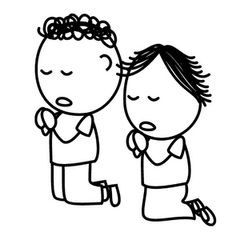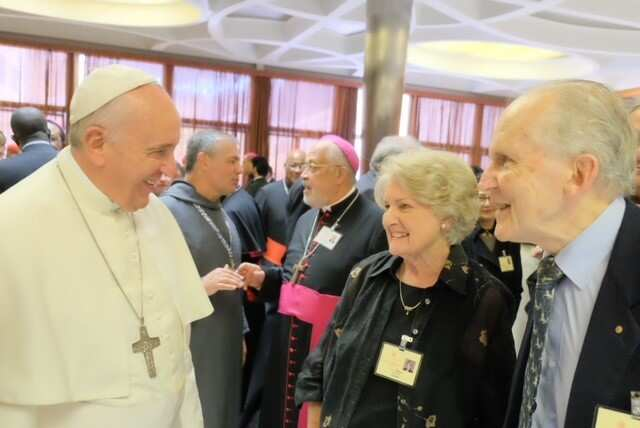Couple Prayer

by Ron and Mavis Pirola
In this year of Prayer and in preparation for the Jubilee Year of 2025, Pope Francis calls us to rediscover the great value and absolute need for prayer in personal life, in the life of the Church and in the world. So, what would be a better time to address one aspect of this and that is Couple Prayer.
We are no experts on this, but it is something that is important to us personally and we believe that it is a great untapped resource in the life of married couples and in the Church.
We are using the term Couple Prayer to mean husband and wife coming together to pray out loud. In no way does this diminish each individual’s personal prayer. But the essential difference between personal prayer and couple prayer is that someone is listening to some of our deepest inner thoughts and that person is our spouse.
Why should we pray as a couple? What are the advantages?
To us, three reasons stand out:
- One is that it helps to keep our relationship God-centred. If we understand marriage as a sacrament of God’s love for his people, it is very important to keep ourselves focussed on God’s love. By being in a relationship with God as a couple we are better able to realise the purpose of our marriage as a sign of God’s love in the world.
- Secondly, couple prayer activates the graces of our sacrament of Matrimony. These graces go beyond a simple awareness of God’s love. They help us to love each other with the self-giving love with which Jesus loves us and so to handle the inevitable tough times in our relationships and to grow in our love for God through our marriage.
- Thirdly, couple prayer builds intimacy in our relationship. We have certainly noticed in our marriage, that couple prayer seems to be related to intimacy. If we are out of sorts with each other, then couple prayer can seem like the last straw. Or at least it requires a lot of sensitivity to each other to get started. On the other hand, praying together seems to encourage feelings of closeness and trust and greater readiness to engage in sexual intimacy. In lovemaking, sexual intimacy can create an experience of self-abandonment of body, mind and heart into the hands of the one we love, as completely as we can – it can seem like a glimpse of being drawn into the Divine Intimacy – a taste of Heaven.

However, praying together as a couple is surprisingly challenging because in the process we make ourselves vulnerable to each other. When praying on our own, we can be very open with the Lord. We may want to mention any number of personal defects about which we may be concerned. And, of course, sometimes we can’t even face our own weaknesses. We can be in denial about them, or we may try to explain them away on some pretext.
How much harder is it then to raise these issues within earshot of our spouse. Sincere individual prayer involves saying things to the Lord that we don’t normally say out loud in casual conversation. We may even feel unsure about how to pray together. We may feel awkward and inadequate or afraid of being judged. We may even think it is safer to stick to the well-known formal prayers. One needs patience and trust to overcome these reservations. But gradually over time, it has enormous rewards.
It’s different to what normally happens in marriage, where the intimacy of our relationship tends to plateau because we think we know each other well already. But if we develop a habit of working on our intimacy, then we will, with time grow steadily in our relationship. And that is what our sacrament of Matrimony calls us to.
Because of our fear of vulnerability, we can instinctively shy away from couple prayer. That’s why each couple has to do it at their own pace without pressure. And of course, the earlier in marriage that one begins, the easier it will be in later life to experience its benefits. Therefore, it is an important consideration in any marriage preparation course.
We have very little idea of how many couples pray together today. In past years, we have known very many couples who prayed regularly together. It would seem that most of them prayed the rosary and there probably wasn’t much spontaneous prayer around it but it was certainly earnest prayer said by committed couples.
Mavis: My first glimpse of that was as a young child. In my home, there was tension around religion with my father being a Masonic leader and my mother a Catholic. In those days it was a very challenging situation to say the least. But the family across the road would take me to Mass every Sunday. When the husband developed a terminal illness, the day came when he and his wife were waiting in the hall of their home for the ambulance to take him to the hospital for what would be the last time. And what were they doing as they waited? They were holding hands and praying the Rosary. I remember it made a big impression on me – something I have never forgotten.
That sort of natural piety seems to us to have been fairly widespread although it may be declining considerably and rapidly. I remember hearing many times the famous words of Jesus from Mt 18:20 that “wherever two or three of you are gathered in my name I am there among you”. However, generally speaking couple prayer is hardly promoted at all in the Church’s writings. The Catechism of the Catholic Church is a massive tome divided into four parts. The fourth part is on prayer. It contains 7,300 words covering 307 teaching points on prayer and not one touches on couple prayer. Even though the basic human community is the couple.
Even a word search for other possible words for couple prayer, like marital, matrimonial, nuptial, spousal and parental prayer all draw blanks.
One possible explanation for this absence of promotion of couple prayer is that Catholic spirituality is dominated by a long and wonderful tradition of monastic spirituality which unfortunately tends to bypass considerations of marital spirituality. There are some notable exceptions such as St John Paul II’s Theology of the Body. But when it comes to written advice on developing marital spirituality, there is far more emphasis on prayer in general, and on scripture and on the Sacraments than there is on developing the full understanding that Matrimony is a sexual sacrament and that in fact, sexual intimacy is the only feature that distinguishes marital spirituality from other forms of spirituality.
Sociologists are starting to shed light on the subject. Fr Andrew Greeley, a Jesuit sociologist, in his 1991 book, ‘Faithful Attraction’, reported that while the divorce rate in the general United States population was around 50% in new marriages, among regular churchgoers, the divorce rate dropped to 18%. The divorce rate among couples with an active faith life dropped to 8% and among couples with an active faith life who prayed together it dropped to an amazing 0.7%. He concluded that of all the factors known to contribute significantly to marital happiness, praying together as couples was ‘the most powerful correlate of marital happiness that we have yet discovered.’
Other, more recent sociologists have reported that couples who pray together tend to experience better mental and physical health, greater ability and willingness to forgive each other, to show greater gratitude to their spouse, more willingness to sacrifice for the relationship, greater sexual intimacy and a higher level of unity and trust with their spouse.
With all these benefits, and in a society where no one gets married so that they can become divorced, you would think that there would be enormous interest and effort to engage in couple prayer. Yet in reality how aware are most couples of this opportunity?
Couples in lay spirituality movements tend to be relatively open to couple prayer but it seems to us that most couples don’t hear about it and even if they did, they would tend to think that it is too hard.
For us personally, couple prayer certainly has never come easily. And after 65 years of marriage we are still learners. But what helped us in our earliest years of marriage was being touched by couples we met through the Teams Movement, first, and then World Wide Marriage Encounter. Teams taught us the value of what was called a ‘sitting down’ which was a monthly one-hour time of prayerful reflection on our relationship. And Marriage Encounter through daily dialogue gave us a major tool for intimate sharing and prayer together. And in both movements, we were journeying with couples who held similar values.
Ron: So how do we pray as a couple?
First, we make a time that works for both of us, which normally is the early evening.
Then we have a special place for our time together. We are fortunate to have our own ‘prayer nook’ with a small table with a candle, a crucifix and our prayer books and rosary beads. We find it helps us to focus more easily on the presence of the Lord in our lives – and on each other.
Most evenings we pray the Divine Office. We appreciate that we are praying in unity with huge numbers of people around the world. There is something heartening about saying prayers that have been said by God’s people for millennia and that right now unite us. And the psalms are largely expressions of gratitude and praise and give us a sense of the history of God’s people, of God’s promises to his people and of the eventual coming of the Messiah.
There are two places in each daily reading of the Divine Office where we can pause to share with each other our own personal prayers. We use the first pause for prayers of praise and thanks and the second pause for prayers of petition. So, the whole process becomes a mix of formal prayers and spontaneous prayers.
It seems to us that thanksgiving is very important in prayer – both spiritually and psychologically. Each evening, after all the pressures of the day, one’s personal prayers said aloud can remind each other of things which we have forgotten about or which we have taken for granted and the many blessings that we have received. Our prayers of thanksgiving may not be very long, but they tend to build a habit of gratitude.
There are many other things that we often include in our evening prayer, like a decade of the rosary, maybe a special novena or Lenten or Advent reflections. Sometimes we chuckle that it’s a bit like O’Brien’s poem about the ‘Trimmins on the Rosary’. But it’s a special time and it works for us now.
Of course, in earlier years with the incredible chaos of young children and work commitments, it was a challenge to find ten minutes together.
However, there are so many ways in which we can pray together. The habit of grace before meals is an obvious one. We can hold hands, thanking God for the food that we are about to eat and asking God’s blessing on our conversation. We can pray for a safe journey while just driving. We can give each other a blessing as we leave the home. It could be a sign of the cross on the forehead or just a simple, ‘God bless you’. We can walk around the block together and pray as we walk. We can read scripture together – or alone and share on it later when we are together.
And our Catholic faith offers many age-old practices that can add more depth and meaning to prayer. For example, the Litany of the Saints, Lectio Divina, novenas. Some couples find great meaning in going to Eucharistic adoration together – sitting with the Lord together in silent prayer can be a powerful bonding time.
The important thing that we need to remember about couple prayer is that it is not about technique; it’s about relationship – our relationship with God through our relationship with each other. So, there is no right or wrong way. Everybody does it differently and the important thing is to just do it.
And a commitment to daily couple prayer is an important habit. Maybe it’s a bit like physical exercise. We don’t always feel like it, but consistency is good and letting it slip when we don’t feel like it can lead to letting it slide away altogether.
And just as it is hard to tell exactly how much exercise improves your health, it’s difficult to know how much our couple prayers are answered. But one thing we can say is that we have had an extraordinarily blessed life and some of our greatest blessings have come at a time when we were engaged in couple prayer.
One final point is that we think that couple prayer is important with regard to family prayer. One thing that seems to be very common with regard to family prayer is that it works very well and relatively easily and beautifully with young children. They seem to enjoy the ritual of saying ‘thankyou’ prayers and ‘sorry prayers and ‘please’ prayers; it’s often a beautiful bonding time around a candle and a cross.
However, somewhere around early teen years, it seems to start to fall away. Our impression is that very few teenagers are involved in family prayer.
We wonder if the situation could be improved by the parents themselves being more comfortable with praying together. One would think that should at least help with family prayer.
So, in summary:
- Couple prayer is a great untapped resource in the life of married couples and in the Church.
- Couple prayer strengthens our relationship and brings us closer to God.
- It is not easy, but it can be extremely flexible and the basic rule is to just do it.
- The question remains how can the gifts of praying as a couple be promoted and encouraged?

Ron e Mavis Pirola meeting Pope Francis





Some times we have found that the only way we can get back together after feeling separated is to give each other a hug (being humble because we just con’t know how to re-connect) and say the Our Father… and He comes through every time. Thank you God
Thank you so much.
Very wise advice thank you